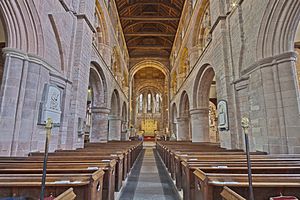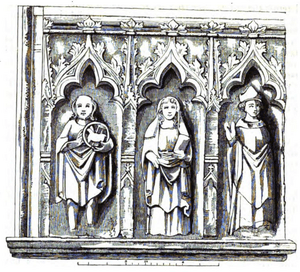Robert of Shrewsbury (died 1168) facts for kids
Quick facts for kids Robert of Shrewsbury |
|
|---|---|
| Abbot of Shrewsbury | |

Interior of Shrewsbury Abbey
|
|
| Church | Catholic |
| Archdiocese | Province of Canterbury |
| Appointed | 1148 |
| Reign ended | 1168 |
| Predecessor | Ranulf |
| Successor | Adam |
| Personal details | |
| Born | Possibly Downing, Flintshire |
| Died | 1168 Shrewsbury |
| Previous post | Prior of Shrewsbury |
Robert of Shrewsbury (who died in 1168) was a Benedictine monk. He became a prior and later the abbot of Shrewsbury Abbey. He was also known for writing stories about saints.
Contents
Who Was Robert of Shrewsbury?
Robert was a common name in the 1100s, especially among the Anglo-Norman people who ruled England. So, there were many people named Robert of Shrewsbury. This Robert was a monk, and he is different from another Robert of Shrewsbury who became a bishop.
It's thought that Robert the monk might have been from a family called Pennant. They lived near Holywell, which is famous for the spring of Saint Winifred. He probably wasn't born in Shrewsbury. His name "of Shrewsbury" likely came from his long time at the Abbey there. He first appeared as a prior at the Abbey in 1137. This suggests he was born around the early 1100s.
Robert as a Prior
As a prior at Shrewsbury Abbey, Robert is famous for helping to make Saint Winifred more well-known. He did this by moving her holy remains (called relics) from a place called Gwytherin to Shrewsbury Abbey. He also wrote the most important story about her life.
Robert wrote his own account of moving St Winifred's relics. He said that the monks at Shrewsbury Abbey, after it was built, wished they had more relics of saints. They heard that many saints' bodies were in Wales.
During the time of King Henry I, one monk got very sick. The sub-prior, Ralph, had a dream. In his dream, a beautiful young woman told him the sick monk would get better if they went to celebrate Mass at St Winifred's spring. Ralph was scared to tell anyone, fearing they would laugh at him. He waited until the monk had been sick for 40 days. As soon as he told the others, two priests were sent to Holywell to celebrate Mass. The sick monk immediately started to get better. He became completely well after visiting the shrine and bathing in the spring.
The Journey for St Winifred's Relics
Robert wrote that he and another monk named Richard were sent by Abbot Herebert. Their job was to arrange for St Winifred's relics to be moved. They took advantage of a short period of peace in 1137. This was during a difficult time in England called the Anarchy, when there was fighting for the throne.
They spoke to the Bishop of Bangor, David the Scot, and a local Welsh prince. Then, they gathered a group of seven people, including the prior of Chester, to collect the saint's body. At first, the local people did not want the relics to be moved. But a helpful dream convinced the local priest to gather everyone.
Robert spoke to the crowd through an interpreter. He told them that he and his friends had come to get St Winifred's body. He said she wanted to be honored in their city and monastery. He also said that the saint herself had shown her wishes in visions. He warned that she would be unhappy with anyone who tried to stop what she wanted.
This speech convinced most people. Only one man still disagreed, but he was given money to agree. This cleared the way for the relics to be moved. Robert claimed that he could magically find Winifred's grave, even though he had never been there before. The body was dug up and carried to Shrewsbury. This journey took seven days.
The relics were first placed in St Giles' church. They waited there for the permission and presence of the Bishop of Coventry and Lichfield. After more amazing events, the relics were finally carried in a procession into the town. Many people came to see this special event. The relics were then placed on the altar of the Abbey church, where more miracles were reported.
Robert's story of St Winifred and how her relics were moved was likely written in 1139. This was just over a year after his trip to Wales.
Robert as an Abbot
Herebert, the abbot who sent Robert to Wales, was removed from his position in 1138. The reasons are not fully known. He was followed by Ranulf, who was abbot until 1147. Robert of Shrewsbury likely became the fifth abbot of the Abbey in 1148.
Not much is known about his time as abbot. However, he successfully got back two parts of the church taxes (called tithes) from Emstrey parish church. These taxes had been given away by the previous abbot, Ranulf, to another church. Emstrey was a large and important area for Shrewsbury Abbey.
His Death
Robert's death year is sometimes listed as 1167. However, historians now generally agree that he died in 1168. This date is written in the records of Tewkesbury Abbey. It is believed he died and was buried at Shrewsbury Abbey.
Robert in Stories
Robert of Shrewsbury appears in The Cadfael Chronicles, a series of mystery novels by Edith Pargeter (who wrote as Ellis Peters). In these stories, he is a main character who often causes problems for the hero, Brother Cadfael. Robert is shown as being very strict and ambitious. He feels uneasy around Cadfael, who is honest and self-reliant.
The first book in the series, A Morbid Taste for Bones, retells Robert's own story of moving St Winifred's relics. But in the book, it becomes a murder mystery! The TV show based on the books changed the order of events. It started with One Corpse Too Many, which is about the king's forces attacking Shrewsbury. This event actually happened a year after the relics were moved. Edith Pargeter used the real facts about Robert's life to create interesting stories.



